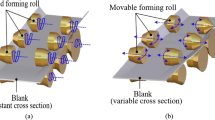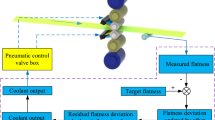Abstract
The finishing train of a hot strip mill has been modelled by using a constant volume element model. The accuracy of the model has been increased by using an Artificial Neural Network (ANN). A non-linear Rank Based Genetic Algorithm has been developed for the optimization of the work roll profiles in the finishing stands of the simulated hot strip mill. It has been compared with eight other experimental optimization algorithms: Random Walk, Hill Climbing, Simulated Annealing (SA) and five different Genetic Algorithms (GA). Finally, the work roll profiles have been optimized by the non-linear Rank Based Genetic Algorithm. The quality of the strip from the simulated mill was significantly improved.
Access this chapter
Tax calculation will be finalised at checkout
Purchases are for personal use only
Preview
Unable to display preview. Download preview PDF.
Similar content being viewed by others
References
Wilms, Vogtmann, Klöckner, Beisemann, Rohde: Steuerung von Profil und Planheit in Warmbreitbandstraßen, Stahl u. Eisen 105 (1985) Nr. 22, pp 1181–1190
Hensel, Poluchin: Technologie der Metallformung, Deutscher Verlag für Grundstoffindustrie, Leipzig, 1990
Sheppard, Roberts: Shape Control and Correction in Strip and Sheet, International Metallurgical Reviews 1973, Vol. 8, pp 1–17
Emicke, Lucas: Einflüße auf die Walzgenauigkeit beim Warmwalzen von Blechen und Bändern, Neue Hütte, 1. Jg. Heft 5, 1956, pp 257–274
Takashi, Satou, Yabuta: Adaptive Technology for Thickness Control of Finisher Set-up on Hot Strip Mill, ISIJ International, Vol. 35 (1995), No. 1, pp 42–49
Ortmann, Burkhard: Modernisierung der Automatisierungssysteme der Warmbreitbandstraße bei Voest-Alpine Stahl Linz, Stahl u. Eisen 115 (1995) Nr.2, pp 35–40
Nolle, Armstrong, Ware: Optimisation of Work Roll Profiles in a 2-hight Rolling Mill Stand by Means of Computational Intelligence, Proc. of the 4th Int. Mendel Conf, Brno, 1998, pp 277–284
Hensel, Arnold, Thilo Spittel: Kraft-und Arbeitsbedarf bildsamer Formgebungsverfahren, VEB Deutscher Verlag für Grundstoffindustrie, Leipzig, 1978
Winkler W.: Theoretische Untersuchungen über die Einflüße, welche die Stärkenunterschiede beim Warmwalzen von Breitstreifen bestimmen, Dr.-Ing. Dissertation, TH Achen, 1943
Wusatowski, Zygmunt: Fundamentals of Rollling, Pergamon Press Ltd, Oxford, London, Edinburgh, 1969
Portmann, Lindhoff, Sorgel, Gramckow: Application of neural networks in rolling mill automation, Iron and Steel Engineer, Feb. 1995, pp 33–36
Hornik Stinchcombe, White: Multilayer Feedforward Networks are Universal Approximators, Neural Networks, Vol. 2, 1989, pp 359–366
Hornik: Approximation Capabilities of Multilayer Feedforward Networks, Neural Networks, Vol. 4, 1991, pp 251–257
Picton, Phil: Introduction to Neural Networks, The MacMillian Press LTD, 1994
Sprecher, D.: On the Structure of Continuous Functions of Several Variables, Transaction of the American Mathematical Society, Vol. 115, 1964, pp 340–355
Baker: Adaptive Selection Methods for Genetic Algorithms, Proc. on an Int. Conf. on GA’s and Their Application, Hilldsdale, 1985, pp 101–111
Kirkpatrick, S., C.D. Gelatt, Jr., M. P. Vecchi: Optimization by Simulated Annealing, Science, 13 May 1983, Vol. 220, No. 4598
Metropolis, A, W. Rosenbluth, M. N. Rosenbluth, H. Teller, E. Teller: Equation of State Calculations by Fast Computing Machines, The Journal of Chemical Physics, Vol. 21, No. 6, June 1953
Syswerda: Uniform Crossover in Genetic Algorithms, Proceedings of International Conference on Genetic Algorithm 1989 (ICGA’89), pp 2–9
Author information
Authors and Affiliations
Editor information
Editors and Affiliations
Rights and permissions
Copyright information
© 1999 Springer-Verlag Berlin Heidelberg
About this paper
Cite this paper
Nolle, L., Armstrong, A., Hopgood, A., Ware, A. (1999). Optimum Work Roll Profile Selection in the Hot Rolling of Wide Steel Strip Using Computational Intelligence. In: Reusch, B. (eds) Computational Intelligence. Fuzzy Days 1999. Lecture Notes in Computer Science, vol 1625. Springer, Berlin, Heidelberg. https://doi.org/10.1007/3-540-48774-3_50
Download citation
DOI: https://doi.org/10.1007/3-540-48774-3_50
Publisher Name: Springer, Berlin, Heidelberg
Print ISBN: 978-3-540-66050-7
Online ISBN: 978-3-540-48774-6
eBook Packages: Springer Book Archive




